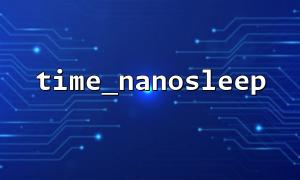In PHP programming, time_nanosleep() is a function used to implement nanosecond delays. The function prototype is as follows:
bool time_nanosleep(int $seconds, int $nanoseconds): bool|array
The main purpose of this function is to pause the specified time during script execution, where the $seconds and $nanoseconds parameters together determine the total duration of sleep. However, during the use of time_nanosleep() , if the process receives a POSIX signal, sleep may be interrupted, which involves its interaction with the POSIX signaling mechanism.
POSIX signals are mechanisms used by Unix and Unix-like systems to notify processes of certain asynchronous events (such as interrupts, terminations, pending, etc.) to occur. During operation, a process can register a signal processor (handler) to respond to a specific signal.
For example:
pcntl_signal(SIGINT, function() {
echo "Received SIGINT Signal,Execute interrupt processing logic。\n";
});
When the PHP script calls time_nanosleep() to enter sleep state, the operating system will set the process to a blocking state until the specified time passes or a signal interrupts sleep. Once the signal breaks sleep, time_nanosleep() does not simply fail to return false , but returns an array containing the remaining sleep time.
For example:
$result = time_nanosleep(5, 0);
if (is_array($result)) {
echo "sleep Being interrupted,time left:{$result['seconds']} Second {$result['nanoseconds']} 纳Second\n";
}
If the developer wants to continue completing the remaining sleep after the signal is interrupted, he can use loop logic to retry time_nanosleep() as follows:
$seconds = 5;
$nanoseconds = 0;
while (true) {
$result = time_nanosleep($seconds, $nanoseconds);
if ($result === true) {
break; // Successfully completed dormant
} elseif (is_array($result)) {
$seconds = $result['seconds'];
$nanoseconds = $result['nanoseconds'];
echo "被Signal中断,继续time left的休眠...\n";
} else {
echo "An error occurred,Jump out of sleep。\n";
break;
}
}
To demonstrate the situation where time_nanosleep() is interrupted by a signal, it can be combined with pcntl to expand the analog signal interrupt:
declare(ticks = 1);
pcntl_signal(SIGUSR1, function() {
echo "Received SIGUSR1 Signal\n";
});
echo "Begin sleeping...\n";
$pid = getmypid();
$url = "https://gitbox.net/send_signal.php?pid=$pid";
echo "Please visit $url Send to the process SIGUSR1 Signal\n";
$result = time_nanosleep(10, 0);
if (is_array($result)) {
echo "sleep Being interrupted,Remaining:{$result['seconds']} Second {$result['nanoseconds']} 纳Second\n";
} else {
echo "sleep Completed normally。\n";
}
Note: The above URL example uses the gitbox.net domain name, indicating that a hypothetical interface can send signals to the target process.
Unlike sleep() and usleep() , time_nanosleep() more explicitly exposes the state of interruption by the signal, which makes it more reliable when writing more detailed control logic to respond to the signal. When sleep() is interrupted, only the remaining seconds are returned, while usleep() fails directly and does not provide the remaining time.
The time_nanosleep() function can not only accurately control the sleep time of the PHP program, but also interact well with the POSIX signaling mechanism. When the program is performing sleep, if a signal interrupt is encountered, the remaining time can be obtained by checking the return value and continuing to sleep, which enhances the script's response ability to external events. This capability is especially important when writing long-running scripts that require processing asynchronous signals.














